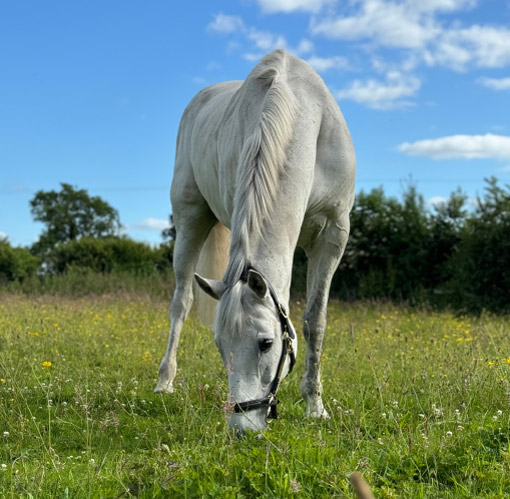By D&H's Equine Community Nutritionist, Emma Nissler BSc(Hons), ANutr
Summer is one of the best times to enjoy your horse. Sunny rides, long summer hacks, and seeing them out in the field without rugs on, soaking up the sunshine on their back. For many, it’s the season that reminds us why we do it.
With the abundance of lush grazing that summer often brings, it’s the perfect time to make the most of turnout. But as with everything in horse care, a little knowledge goes a long way. Understanding how summer grass changes - and how this might affect your horse - helps keep them feeling their best and makes managing their diet that little bit easier. With this in mind, we’ve gathered some simple tips and information to help you support your horse’s health and wellbeing this season, so you can spend more time enjoying summer together.
When is grass sugar high?
Grass naturally contains sugar in the form of Water-Soluble Carbohydrates (WSCs), and the levels can change depending on weather and growing conditions. It’s helpful to be aware of when sugar levels tend to rise so you can make informed decisions about turnout routines or feeding.
In Spring and Autumn, sugar levels are typically higher, especially when sunny days are followed by cooler nights. During the day, grass plants use sunlight to produce sugar through photosynthesis. If the temperature drops below 8°C overnight, the plant can’t use that sugar to grow, so more of it stays stored in the grass - which means your horse is more likely to consume it during grazing.
· A sunny day followed by a frosty night = high sugar
· A cloudy day followed by a frosty night = medium to high sugar
· A cloudy day followed by a rainy night = medium sugar
If soil temperatures stay above 8oC at night, the grass is able to use its energy stores from the day to grow, naturally reducing its sugar content.
· A sunny day followed by a mild night = low sugar in the morning, medium in the afternoon
· A rainy day followed by a mild night = low sugar
· A long, dry sunny spell = sugar levels can still be high, although growth may slow down if it becomes too dry
Easy ways to manage summer grazing
Every horse is different, and while many thrive on summer turnout, some - particularly those that may be prone to weight gain or laminitis - may benefit from a bit of extra management during the grazing season. The good news is there are lots of simple, effective ways to do this while still allowing your horse to enjoy time in the field.
· Overnight grazing – Turning out overnight, when sugar levels are often lower, can be a great option for horses that need a little more support. Many horses also graze less intensively during the cooler hours.
· Strip grazing – This involves gradually allowing access to fresh grass using electric fencing. Ideally, set up two fences: one to allow access to new grazing, and one behind. This helps maintain a consistent grazing area and makes it easier to manage grass intake.
· Alternative fibre sources – If you need to reduce grass intake, you can keep your horse’s fibre intake topped up with hay or fibre-based products like chaffs and mashes.
· Grazing muzzles – These can be a helpful tool for horses that still benefit from turnout but need their grass intake reduced. Muzzles work by limiting bite size and often result in more mindful grazing. They’re most effective when used alongside other practices like strip grazing or restricted grazing time, and always with good supervision to ensure the horse is happy and comfortable wearing one. It’s important to not leave muzzles on all day and to ensure they know how to drink when wearing them.
With a little planning, managing your horse’s summer grazing doesn’t need to be complicated — and it definitely doesn’t need to get in the way of enjoying the season. By understanding how grass changes and using some of the tips above, you’ll be in a great position to keep your horse healthy and happy all summer long.
Should I still feed a balancer?
Summer grass is a fantastic natural source of many key nutrients, including vitamins A, E, and C, as well as a variety of important minerals like calcium, magnesium and potassium. But while grazing offers lots of goodness, the exact levels of nutrients can vary depending on the time of year, the weather, and soil conditions - meaning your horse might not always get everything they need.
That’s where a balancer or vitamin and mineral supplement can really help. These products provide consistent nutrition to support coat condition, muscle development and overall health - even when grazing is at its best. Including one in your horse’s diet is an easy way to give you peace of mind that all their nutritional bases are covered, so they can feel and look their best throughout the summer.


